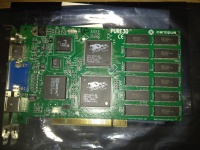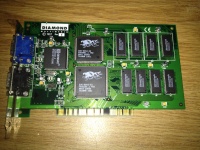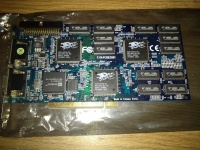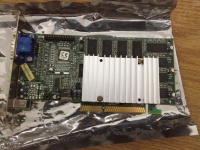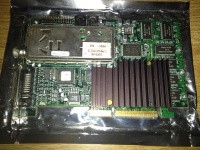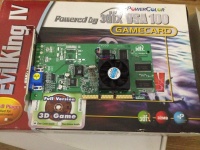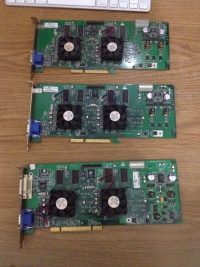Difference between revisions of "3dfx"
RacoonRider (Talk | contribs) (→Voodoo Graphics) |
D1stortion (Talk | contribs) |
||
| Line 1: | Line 1: | ||
| − | 3Dfx was a 3D graphics | + | 3dfx (written as 3Dfx until 1999) was a 3D graphics chipset manufacturer and later on graphics card manufacturer. Founded in 1994, the company was one of the pioneers of 3D graphics in the PC industry in the mid to late 1990's. They played an important role in the business until 2000, when most of their assets were purchased by Nvidia Corporation, after which the company filed for bancruptcy and officialy went defunct in 2002. |
| − | + | ||
== Voodoo Graphics == | == Voodoo Graphics == | ||
| Line 7: | Line 6: | ||
[[File:Voodoo_1.jpg|200px|thumb||Diamond Monster 3D]] | [[File:Voodoo_1.jpg|200px|thumb||Diamond Monster 3D]] | ||
| − | The Voodoo Graphics (retroactively named Voodoo 1) was | + | The Voodoo Graphics (retroactively named Voodoo 1) chipset was 3dfx's first foray into the PC market. Its release in 1996 was primarily made possible by EDO DRAM declining in price. The cards, which were manufactured by board partners, feature a frame buffer processor, a texture processor, a DAC and 4 MB EDO DRAM (some later versions were released with 6 or even 8 MB). Both the RAM and graphics processors operate at 50 MHz, with 2 MB RAM being used as framebuffer and two as texture memory. The chipset was rich in features, boasting perspective correct texture mapping, bilinear texture filtering, level of detail MIP mapping, sub-pixel correction, polygonal-based Gouraud shading and texture modulation. It natively supported Direct3D and introduced Glide, 3dfx's own proprietary API that worked initially under DOS and later under Windows 9x and NT 4.0/2000/XP. Glide was essentially a cut down OpenGL implementation, with no support for features such as 32-bit color depth. OpenGL games were initially only supported through the use MiniGL, which were incomplete OpenGL implementations tailored for the particular target card and game. In 1999, 3dfx released a full OpenGL ICD, thus finally granting native support for OpenGL games. |
| − | + | ||
| − | + | ||
| − | + | ||
| − | + | ||
| + | The main disadvantage of the cards was that they could only do 3D, meaning that they had to be used in conjunction with a standard 2D card through means of a passthrough cable. During boot and regular PC operation the 2D card would display the image like usual and run the signal through the Voodoo; however, when a compatible game was ran, the Voodoo Graphics would be enabled, taking over the host card. Combinations with S3 Graphics cards, as well as Matrox cards were quite popular. Unfortunately, the passthrough method was very dependend on the cable used and could potentially lead to blurriness. | ||
| + | Thanks to 3dfx's efforts with videogame developers and publishers - the company's technology was quickly adpoted as the de-facto standard in PC 3D gaming - the Voodoo 1 enjoyed a lengthy support from game developers. Despite only supporting resolutions as high as 640x480 (800x600 without the usage of Z-buffering) and 16-bit depth, the card was more or less usable until 1999, when its performance in new games would have been slow. | ||
'''Direct competitor cards:''' | '''Direct competitor cards:''' | ||
Revision as of 16:08, 18 February 2013
3dfx (written as 3Dfx until 1999) was a 3D graphics chipset manufacturer and later on graphics card manufacturer. Founded in 1994, the company was one of the pioneers of 3D graphics in the PC industry in the mid to late 1990's. They played an important role in the business until 2000, when most of their assets were purchased by Nvidia Corporation, after which the company filed for bancruptcy and officialy went defunct in 2002.
Voodoo Graphics
The Voodoo Graphics (retroactively named Voodoo 1) chipset was 3dfx's first foray into the PC market. Its release in 1996 was primarily made possible by EDO DRAM declining in price. The cards, which were manufactured by board partners, feature a frame buffer processor, a texture processor, a DAC and 4 MB EDO DRAM (some later versions were released with 6 or even 8 MB). Both the RAM and graphics processors operate at 50 MHz, with 2 MB RAM being used as framebuffer and two as texture memory. The chipset was rich in features, boasting perspective correct texture mapping, bilinear texture filtering, level of detail MIP mapping, sub-pixel correction, polygonal-based Gouraud shading and texture modulation. It natively supported Direct3D and introduced Glide, 3dfx's own proprietary API that worked initially under DOS and later under Windows 9x and NT 4.0/2000/XP. Glide was essentially a cut down OpenGL implementation, with no support for features such as 32-bit color depth. OpenGL games were initially only supported through the use MiniGL, which were incomplete OpenGL implementations tailored for the particular target card and game. In 1999, 3dfx released a full OpenGL ICD, thus finally granting native support for OpenGL games.
The main disadvantage of the cards was that they could only do 3D, meaning that they had to be used in conjunction with a standard 2D card through means of a passthrough cable. During boot and regular PC operation the 2D card would display the image like usual and run the signal through the Voodoo; however, when a compatible game was ran, the Voodoo Graphics would be enabled, taking over the host card. Combinations with S3 Graphics cards, as well as Matrox cards were quite popular. Unfortunately, the passthrough method was very dependend on the cable used and could potentially lead to blurriness.
Thanks to 3dfx's efforts with videogame developers and publishers - the company's technology was quickly adpoted as the de-facto standard in PC 3D gaming - the Voodoo 1 enjoyed a lengthy support from game developers. Despite only supporting resolutions as high as 640x480 (800x600 without the usage of Z-buffering) and 16-bit depth, the card was more or less usable until 1999, when its performance in new games would have been slow.
Direct competitor cards:
Matrox Millennium II/Mystique
ATi Rage II/IIc/Rage Pro
S3 Virge
Nvidia NV1/Riva 128
Rendition Verite 1000
Voodoo Rush
The first 2d and 3d in one graphics card by 3dfx.
Voodoo 2
Banshee
Voodoo 3
